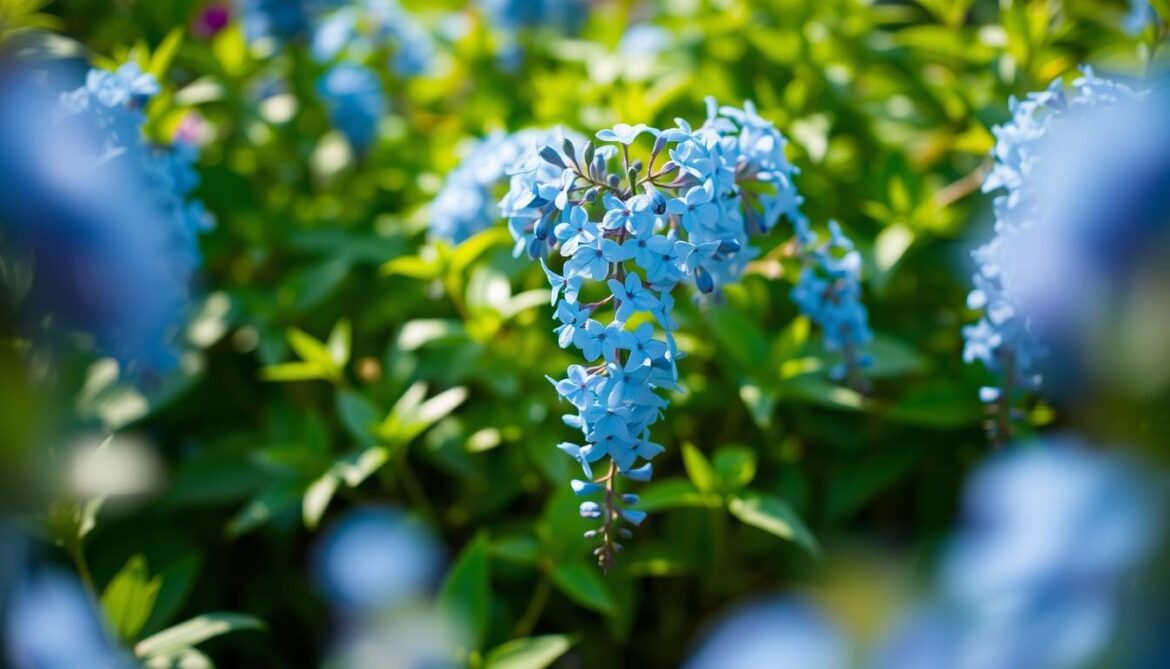Have you ever seen a garden that took your breath away with its colors? That’s what plumbago blue does. For years, it has made gardens in Southern California and Florida come alive with its bright blue flowers. Imagine seeing electric-blue blooms hanging over walls or lining paths.
This is what the plumbago blue plant brings to American gardens. It adds a bold, lasting splash of color to any landscape.
Key Takeaways
- Plumbago blue color adds dramatic contrast to green-dominated gardens.
- Popular in USDA zones 8-11, it thrives in warm climates like Arizona and Texas.
- Its blooms attract bees and butterflies, making gardens eco-friendly.
- Easy to shape as hedges or container plants for porch decor.
- Requires minimal water once established, perfect for water-conscious gardens.
Introduction to Plumbago Blue
Plumbago blue, also known as Plumbago auriculata, is a vibrant flowering shrub. It’s famous for its stunning blue flowers. This plant comes from South Africa and loves warm weather.
It’s a favorite in gardens for its bold blue color. This makes it a top pick for garden designers.
What is Plumbago Blue?
Plumbago blue is part of the Plumbaginaceae family. It grows year-round in mild places. Its stems hold clusters of star-shaped blue flowers that bloom from spring to fall.
The leaves are glossy green, adding to the plant’s beauty. It’s great for making hedges or cascading displays in gardens.
The History of Plumbago Blue
Plumbago blue was introduced to American gardens in the 1800s. It was loved for its exotic look. It was first seen in Florida and California, where it thrived in the warm weather.
It quickly became popular in coastal gardens. A 19th-century journal praised its “rare cobalt hues,” making it famous.
Popular Uses in Landscaping
Plumbago blue is great for many landscaping uses:
- Border plants to frame garden beds
- Privacy hedges due to its dense growth
- Container plants for patios or decks
Its blue flowers also attract butterflies. This makes it good for the environment. Gardeners often use it with white or green plants to show off its color.
Characteristics of Plumbago Blue
Plumbago blue plant is known for its elegance and toughness. It has a striking look and can thrive all year.
Growth Habits and Size
This semi-woody shrub grows 3–10 feet tall and 6–8 feet wide. It spreads fast, doing well in USDA zones 8–11. Its vines can spill over walls or create thick hedges.
Regular pruning helps keep its shape and promotes bushy growth.
Foliage and Flower Description
Narrow oval leaves stay green all year in mild weather. They provide a backdrop for the plumbago blue flower. The flowers are small, star-shaped, and bloom in clusters.
The plumbago blue color can range from sky blue to deep azure. This depends on the sun and soil. Pair it with plants like those in top purple flower bushes.
Seasonal Color Changes
Spring is when the first blooms appear, reaching their peak in summer. In cooler weather, the flowers may fade, but the leaves stay bright. In frost-free areas, the blue color stays all year.
In colder places, it goes dormant in winter. But with the right care, new growth starts in spring.
Growing Plumbago Blue
Learning how to care for the plumbago blue plant is key to its growth and beauty. It thrives in gardens or containers when its needs are met. Start by matching its natural habitat to your garden or container.
Ideal Growing Conditions
- USDA zones 8-11 offer the best climate, but container growers in cooler areas can use tips from this guide.
- Plant in spring when frost is gone, making sure soil is warm enough for germination and root growth.
Soil Requirements
Soil needs to drain well to avoid root rot. Add compost or sand if your soil is too dense. Aim for a slightly acidic to neutral pH (6.0–7.5).
Light and Temperature Preferences
Full sun (6+ hours daily) boosts blooms, but afternoon shade is better in hot areas. Keep it from freezing below 28°F (-2°C) with mulch or frost cloths. For zone 7-8, protect roots like you would for poblano peppers.
Good plumbago blue care means balancing water and sun. Don’t let the soil get too wet and protect it in cold zones. With these tips, this South African native will thrive in many gardens.
Caring for Plumbago Blue
Learning plumbago blue care helps this colorful shrub grow well every year. It’s important to focus on three main areas: keeping it watered, fed, and groomed.
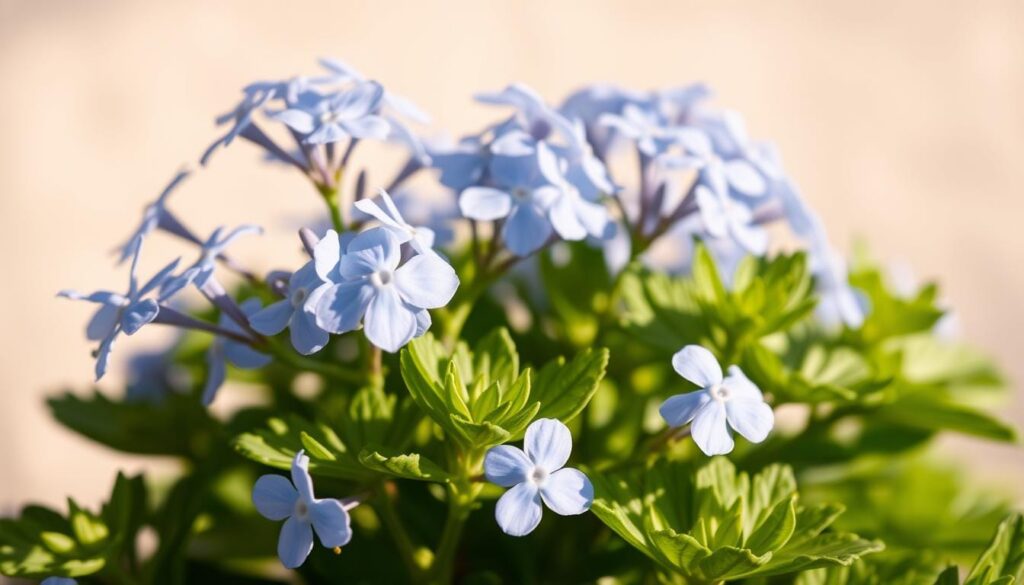
Watering Guidelines
- Water new plants deeply once a week until they settle.
- Water every two weeks in spring and summer, skipping when it rains.
- In winter, let the soil dry out completely to avoid root rot.
Fertilization Techniques
Use slow-release 10-10-10 fertilizer in early spring to boost blooms. Stay away from fertilizers that make leaves grow too much. For older plumbago blue plant plants, use half the amount during growing seasons.
Pruning and Deadheading
Prune back overgrown stems right after they stop blooming to promote more flowers. Cut out dead branches in late winter to encourage new growth in spring. Deadheading—removing old flowers—keeps the plant blooming longer by focusing energy on new buds.
“Pruning in late fall can reduce winter dieback risks in colder zones.”
Pest and Disease Management
Keeping your plumbago blue plant healthy means watching out for pests and diseases. Catching problems early helps a lot. Regular checks and the right treatments keep these colorful shrubs safe.
Common Pests Affecting Plumbago
Whiteflies, spider mites, and scale insects love plumbago. Look for yellow leaves, sticky spots, or bugs on stems. Use neem oil or insecticidal soap for a natural fix. If you prefer chemicals, follow the instructions on the label.
Potential Diseases and Treatments
Plumbago can get leaf spots, powdery mildew, and root rot. Powdery mildew looks like white dust on leaves. Use sulfur-based fungicides to treat it.
Root rot happens when plants get too much water. Improve drainage by adding sand or gravel to the soil. Get rid of any infected parts right away.
Prevention Tips
- Give plants enough space for air to flow and prevent disease.
- Water at the soil level to keep leaves dry and stop fungus.
- Check your plants every week and cut off any sick parts quickly.
“Regular checks are essential to stop pests. Healthy plants fight off bugs better,” says the University of Florida Extension.
Landscaping Ideas with Plumbago Blue
Plumbago blue landscaping is full of possibilities. Its bright plumbago blue flower looks great with many garden styles. It works well in pots, borders, or large groups, adding beauty all year.
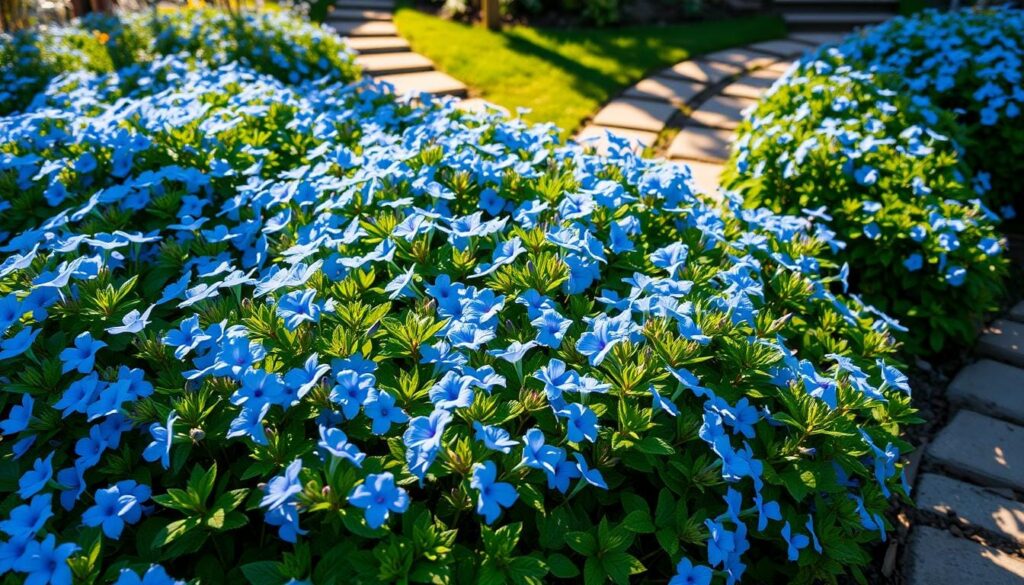
Container Gardening Solutions
Plant plumbago blue in big pots (at least 18 inches wide) for patios or decks. Mix it with plants like purple petunias or variegated ivy for a nice contrast. Make sure pots have holes for water to drain and use soil that drains well.
“Pairing plumbago with bright annuals creates a dynamic focal point,” says landscape designer Maria Green.
Ground Cover Mastery
Use plumbago as ground cover on slopes or open areas. Plant them 3–5 feet apart for a thick, flowering layer. Light pruning in spring keeps it looking neat. It’s also good for dry areas because it doesn’t need much water.
Accent Plant Pairings
- Combine with yellow lantana for warm contrast
- Pair with white gaura for monochromatic elegance
- Accent with red salvias to highlight blue blooms
Use the 60-30-10 rule to balance colors. 60% should be neutral greens, 30% complementary colors, and 10% plumbago blue as the main attraction.
Plumbago Blue Varieties
Choosing the right plumbago blue plant variety is key for a vibrant garden. Gardeners in the U.S. have many options. These options fit different spaces and styles.
Popular Cultivars to Explore
- Royal Cape: It has deep blue flowers and does well in partial shade. It’s great for shaded areas.
- Imperial Blue: This compact variety is perfect for small spaces or containers. It grows 3-4 feet tall.
- Alba: This white-flowered version adds a nice contrast to gardens with lots of color.
Comparisons with Other Blue Plants
When picking blue flowers, know the differences:
- Blue Daze (evolvulus): It loves full sun but has smaller flowers than plumbago.
- Delphinium: Its tall spikes stand out against plumbago’s spread. Delphinium needs cooler weather.
- Blue Sage: It has fragrant leaves but blooms less than plumbago.
In zones 8-10, plumbago beats these plants in heat tolerance. Before planting, check for purple-flower weeds to avoid confusion.
Benefits of Incorporating Plumbago Blue
Plumbago blue plant brings many benefits to gardens. It adds beauty and supports ecosystems. It also adapts well to different conditions.
Attracting Pollinators
Planting plumbago blue attracts pollinators. It draws in ceraunus blue butterflies and bees. This boosts local biodiversity.
- Supports butterfly lifecycle stages
- Encourages natural pest control through pollinator activity
- Increases garden resilience through ecological balance
Enhancing Garden Aesthetics
“Plumbago’s vivid blue blooms act as natural magnets in any landscape,” says the American Society of Landscape Architects. “Its color contrasts beautifully with green foliage and warm-season blooms.”
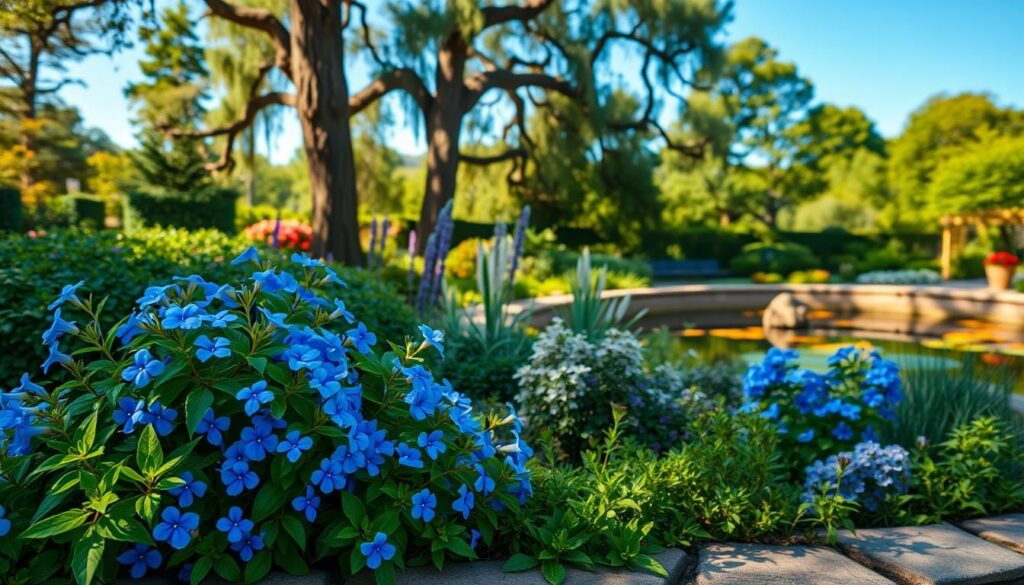
- Create bold focal points in borders
- Add movement with trailing stems in containers
- Balance warm and cool tones in mixed beds
Climate Adaptability
Plumbago blue plant thrives in tough conditions once it’s established. It has several key adaptations.
- Drought tolerance after first growing season
- Heat resistance up to 100°F (38°C)
- Success in USDA zones 8-11 without extra irrigation
Its hardiness makes it perfect for xeriscaping in dry areas.
Environmental Impact
The plumbago blue plant is great for those who care about the environment. It’s easy to take care of, which is good for the planet. It also uses less water and no harmful chemicals, helping our ecosystems stay healthy.
Eco-Friendly Gardening
- Planting it with drought-resistant friends like lavender or sage makes the soil better without using more resources.
- Mulching around it keeps the soil moist and stops weeds from growing.
- It doesn’t get many pests, so you don’t need to use harmful sprays, which is good for animals.
Water Conservation Benefits
After it gets settled, the plumbago blue plant loves deep waterings but doesn’t need them often. Here’s how to care for it:
- Water it deeply every 10–14 days when it’s dry.
- Use drip irrigation to water the roots directly and save water.
In dry places like California or Texas, it can save up to 50% of water compared to other plants. Pair it with native grasses for a garden that saves water and looks beautiful all year.
Plumbago Blue in Different Climates
The plumbago blue plant does well in many places but needs special care. This care depends on the local weather. With the right care, it stays beautiful all year, no matter the climate.
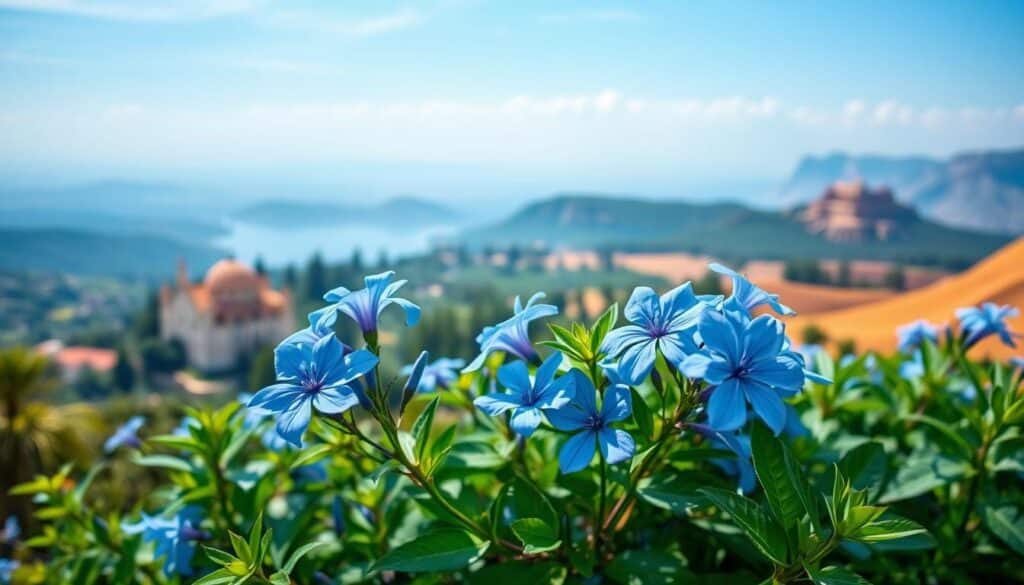
Suitable Zones in the United States
- It’s a perennial in USDA zones 8b–11 (like Southern California, Gulf Coast, Deep South).
- In zones 7–8a (mid-Atlantic, Pacific Northwest), it grows as an annual or in containers.
- Don’t plant it in zones colder than 7a because of the frost.
Temperature Tolerance
Extreme temperatures need special care:
- It can survive as low as 28°F (-2°C). But, frost above 30°F can harm the leaves.
- Use frost cloth or move pots inside when it gets cold.
- It loves the sun but needs some shade when it’s very hot.
Adjusting care for your area helps it grow better:
- In the Southeast, make sure the soil drains well to handle the rain and humidity.
- Southwest gardeners should mulch around the roots to keep the soil moist in dry areas.
- California gardeners should protect it from coastal winds and give it shade in the afternoon inland.
Adjusting care for your area helps it last longer. In areas where the weather changes, growing it in containers makes it easy to move it for protection.
Seasonal Care for Plumbago Blue
Plumbago blue care changes with the seasons to keep it healthy. Adjust your care as temperatures change. This supports its growth and beauty in any plumbago blue landscaping design.
In winter, start with a thick mulch layer around the roots to protect from freezing. Use frost cloth over plants during sudden cold. Potted plants in colder zones should go to unheated garages or sunrooms. This keeps them warm.
In USDA zones 8-11, trim damaged stems in early spring after the frost danger passes.
Summer means keeping an eye on watering—water the soil deeply once a week. Increase to twice weekly during hot spells. Trim long stems by midsummer to encourage new blooms. Cut back on fertilizer in extreme heat to avoid stressing the plant.
In spring, give a balanced fertilizer at planting to boost growth. Fall cleanup removes dead leaves to stop disease. Plants in containers need a slow transition to indoor or outdoor conditions when moving.
- Winter: Mulch, frost cloth, and indoor overwintering
- Summer: Deep watering, midseason pruning, adjusted feeding
- Spring/Fall: Cleanup and fertilizer timing
Adjusting plumbago blue care for each season keeps it looking great. Proper seasonal care makes it a highlight in any plumbago blue landscaping design all year.
Common Misconceptions About Plumbago Blue
Plumbago blue plant often faces misunderstandings that cloud its true nature. This section debunks myths to help gardeners make informed choices.

Toxicity Myths
Many believe plumbago blue plant is dangerously toxic. But, it’s not as harmful as thought. Ingestion might cause mild stomach discomfort, but severe harm is rare.
Seed capsules can stick to clothing or pets because of their adhesive sap. But, the risk of toxicity is low. Research confirms it’s safer than many common garden plants.
Misunderstood Growth Patterns
Myths claim plumbago spreads aggressively. But, it’s actually manageable with regular pruning. This prevents overgrowth.
Blooms peak in summer, not year-round as some assume. This clears up a common misconception.
| Myth | Fact |
|---|---|
| Highly toxic to children/pets | Mild irritation possible but not life-threatening |
| Uncontrollable spread | Manageable with regular trimming |
Plumbago blue meaning also varies culturally. Its flowers symbolize resilience and clarity in some traditions. This contrasts myths about danger.
Proper care aligns with its natural traits. This ensures harmony in gardens.
Where to Buy Plumbago Blue
Looking to add plumbago blue plant or plumbago blue paint to your space? Start by checking local nurseries for a hands-on experience. Or, look online for easy shipping options.
- Choose plumbago blue plant with bright leaves and no yellow spots.
- Ask about the right climate and how to prune it.
- Find disease-resistant types at garden centers.
Online Retail Options:
- Fast Growing Trees and PlantMecca sell plumbago blue plant with live arrival guarantees.
- Most nurseries ship in early spring.
- Read reviews to ensure plants arrive healthy.
For interior design, plumbago blue paint is at Home Depot or Benjamin Moore. Use it on containers or walls to bring in the plant’s beauty. Always check color swatches before buying paint.
Conclusion: Embracing Plumbago Blue in Your Garden
Plumbago blue is a game-changer for gardens, combining beauty with usefulness. Its bright plumbago blue color grabs attention, making it a standout feature. It also grows well in many places, adding value all year.
Lasting Impressions of Plumbago Blue
The plumbago blue meaning goes beyond looks. Its color brings calm, like a summer sky. It fits well in containers or as ground cover, thriving in many U.S. climates.
Choosing plumbago blue means picking a plant that’s both useful and beautiful. Its true-blue flowers make any garden pop, showing vibrant gardening can be simple. It’s a great choice for anyone looking to add color and sustainability to their garden. Let its timeless beauty spark your next gardening project.
